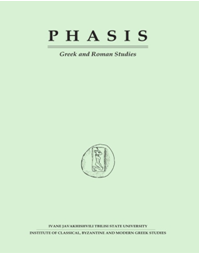Adaptations of Aesopian “Fancy” and Didactics of the “Wisdom” of His Moral in the Works of Prominent Fabulists
DOI:
https://doi.org/10.60131/phasis.17.2014.2326Abstract
The article reviews how Aesopian literature’s legacy – "Fancy" and didactics of "Wisdom" were assimilated by world-famous fabulists. The main motive for Aesop is the dominance of a "sophisticated mind" over physical beauty. Aesop, who was of lowly origin homo de plebe and was strikingly ugly, had an outstanding mental potential. Herodotus’ Histories contain biographical facts about the fabulist; Aristophanes considers unknowing of his fables unacceptable; Wise Socrates was said to rhyme Aesop’s fables to entertain himself while imprisoned. Aesop’s social status led to him using allegory and creating fables where the animal world spoke like humans. The article reviews Aesop’s aspirations, that a human must have spiritual values, wit (fables Aesop on the Deck, The Fox and the Leopard). The theme of spiritual poverty had an influence on La Fontaine (The Fox and the Mask). Human foolishness is displayed in the fable A Swimming Boy, wherein a passer-by sees a boy caught in the current and about to drown, instead of helping he scolds the youngster for his carelessness. We find a similar motive in Sulkhan-Saba Orbeliani’s fable Imprudent Swimmer, who beseeches God for help, his friend advices him to use his own hands to survive. Aesop rejects origin, nobility in fables: The Fox and the Monkey, The Fox and the Crocodile. The main role is given to the interrelation problem between the strong and the weak, which had a great resonance in the writings of many countries. A significant place is given to the following fables: The Lion and the Mouse, The Wolf and the Lamb, The Cat and the Cock, The Eagle and the Bug. In the first fable the king of the predators is freed by the mouse. The following two fables present a similar "verdict" by the wolf and the cat, both of them find the blame for the innocent because they are hungry. The fable The Wolf and the Lamb was assimilated so well first by La Fontaine and then by Krilov that they leave the impression of an original text. As for The Eagle and the Bug, Aristophanes mentions it in The Wasps. The eagle ignored the bug’s pleas and ate the rabbit, which cost it the future children’s lives. The defeat of the mighty lion by the weak, small rabbit and the rescue of other animals is also present in Panchatantra, Book I, Tale VIII. Aesop relentlessly battles against lies and duplicity (The Fox and the Woodchopper) with hidden meanings, allegory, irony and use of other means to teach the generations how to live a proper life.
Downloads
Published
Issue
Section
License
Copyright (c) 2014 PHASIS

This work is licensed under a Creative Commons Attribution-NonCommercial 4.0 International License.


